
My Journey to a More Sustainable Life
You’ve heard of the word sustainability, right? I mean everyone has. What exactly does sustainability mean though? This is the question that I’ve had a really hard time trying to answer over the past few months. Like most people in this day and age, the first place I turned to was Google. In 1987, the United Nations defined the term as “meeting the needs of the present without compromising the ability of future generations to meet their own needs” (United Nations, 2020).
I then asked those around me what the concept of sustainability meant to them. I received a range of different answers, however, I noticed something similar about every single one of them. All of the answers made reference to the environment in some way, shape or form. To be honest I wasn’t too surprised as it was definitely something that popped into my head when I thought about being sustainable. We rely on our planet and its natural environment for so many things like; food, water, energy, materials and even the air we breathe. If sustainability is about protecting the ability of our future generations to meet their own needs, we should be protecting our environment fiercely.
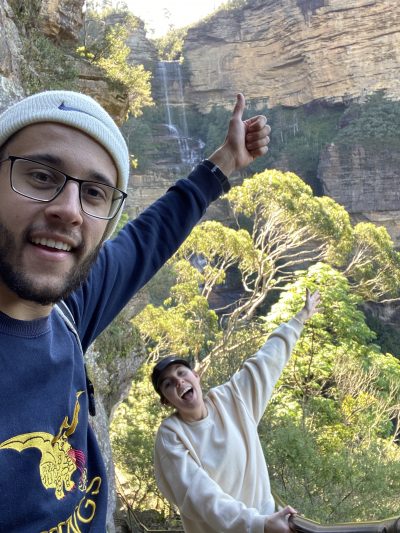
~ Enjoying our natural environment that we need to start protecting ~
I decided to challenge myself to live more sustainably. Firstly, I had to identify the areas of my life that were not as sustainable as they could be. The first, and most obvious, one was my transportation. Transportation accounts for almost a fifth of Australia’s greenhouse gas pollution with cars making up 10% of this (Climate Change Authority , 2019). I used to drive everywhere; to work, to uni, to friends’ houses, even to the gym!
Although the greenhouse gasses that I produced when driving my car would only account for a very small fraction of the total pollution, every bit counts right? So I set myself a goal. I would walk or catch public transport instead of driving my car when I could. I now catch public transport to uni (which has saved me a lot of money as well) and I walk to and from work at least twice a week. This has ended up being my favourite lifestyle adjustment as I find myself feeling better, being more productive and sleeping better due to the extra exercise. I also work at South Bank in Brisbane so I have to walk alongside the river and often see sunsets as beautiful as this one on my way home.

~ The sunset at South Bank on my way home ~
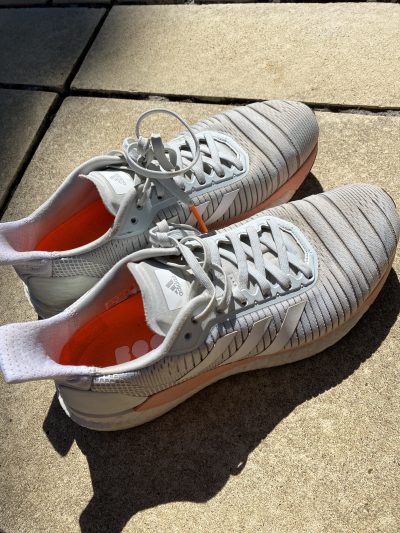
~ My new shoes for my new lifestyle ~
The next area of my life that I believed I could make more sustainable was my clothing. When I need basics, I am definitely guilty of shopping at places like Cotton On, H&M and other fast fashion stores. These were just the easiest and cheapest places to purchase clothing from. However, the fast fashion industry is one of the biggest sources of pollution that exists in our society. It produces greenhouse gasses from production and distribution activities, makes use of precious, non-renewable resources and also creates textiles that can take up to thousands of years to break down if they end up in landfill (UQ Sustainability , 2018). When I discovered how unsustainable the fast fashion industry is, and the extent as to which it is negatively impacting our planet, I knew I had to change my purchasing habits.
I started by looking through my wardrobe. I went through each item of clothing and if I hadn’t worn it at least once in the last month or so I threw it in a pile. I was absolutely appalled when I was finished. The pile on my floor was well over half of the items that used to be hanging in my wardrobe. This is another effect of fast fashion. The constant change in trends, the low price points and the high convenience of shopping at these places sees most of us buying way more clothing than we need. The scary thing is that, in Australia, we end up throwing out over 80% of the textiles that we buy each year (UQ Sustainability , 2018).
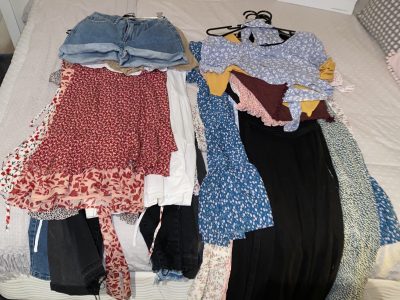
~ The clothes that I decided to clean out of my wardrobe ~
Looking at the huge pile of clothing on my bedroom floor, I just couldn’t stomach the thought of letting that all end up in landfill. I decided to do some research into what I could do with all of this unwanted clothing. It surprised me how many options I found. I could sell them on various platforms such as Depop or Facebook Marketplace and I even found tutorials online of how to make various things such as quilts, pillowcases and blankets out of old, unwanted clothing. However, the option that I ended up choosing was donating them to local thrift shops and charity stores. I live very close to the suburb of Paddington in Brisbane which is home to quite a few thrift stores. So I packed up all the clothing on my floor (ended up being around 8 bags!) and I dropped a few off at a selection of stores. I felt a lot better knowing that not only would my things not end up in landfill, but that they would go to people who were in need of them way more than I was.
Now the next thing that I identified as being an unsustainable practice in my life might be a little surprising; reading. I am an avid reader. I read every single night before I go to sleep and during the day when I feel like I need a little time out from everything else going on in my life. This means I obviously go through a lot of books, which is not only particularly expensive but extremely unsustainable as I rarely read the same book more than once. I had accumulated quite the collection of books which were sitting there untouched. Similarly to what I did with my clothes, I packed them all up and took them to a second hand book store in West End to donate. Although I could have picked up some more books in exchange, I thought that that felt a bit pointless as they would just sit on the same shelf as the last ones. But then I had an idea.
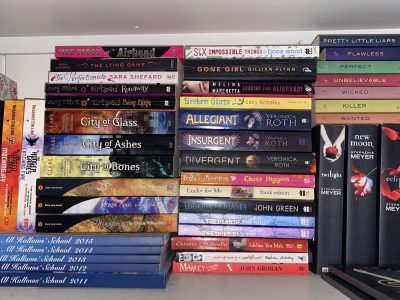
~ All of my old books collecting dust on my shelf ~

~ My new smaller selection of library books ~
When I was younger my grandmother would take my brother and I to the library every time we would go and spend the day with her. I used to love going and picking out a few books to take home that I would then bring back next time we visited. However, I hadn’t stepped foot in that library for a very long time. Now that I am reading more than ever, I thought it would be an excellent idea to go back and renew my membership. So that’s what I did. Now I have maybe 2 or 3 books at a time and once I finish them, I take them back to library and pick up a few others. This is definitely a lot more sustainable than buying brand new books every few weeks, it’s a lot more cost effective too!
The last habit of mine that I wanted to change was to do with what I ate. This one came about a little differently than the others. I was watching the new David Attenborough documentary titled A Life on Our Planet. The documentary detailed the many different insights that Attenborough had accumulated during his time shooting his many different documentaries in many different places around the world. The ones that stood out to me were related to the impact that eating meat has on our environment. Not only can eating meat have immoral consequences but the farming of livestock contributes just under 20% of the total greenhouse gasses that we produce as humans around the world (Vergunst & Savulescu, 2017).
So once again I thought I would set myself another challenge; I would attempt to eat plant based 4 days a week. At first, I did find the transition very difficult but the longer I stuck with it the easier it became, and I soon found myself really enjoying it. I have now made this a permanent part of my lifestyle and while, although I still enjoy the odd cheeseburger or bacon and egg roll from time to time, I eat a considerably smaller amount of meat than I used to.
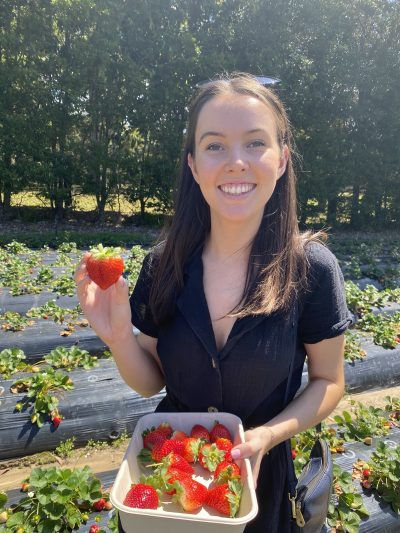
~ Sustainably sourcing my favourite fruit! ~
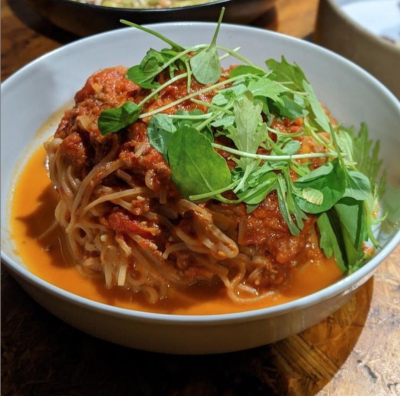
~ A meal from one of my favourite plant based cafes in West End ~
Overall my journey to living a more sustainable life has positively impacted me in ways that I couldn’t have even imagined. Simply changing things about my lifestyle and doing my small part for our environment, has benefitted my mental and physical health so much. I can definitely say that these substitutions and alterations are ones that are going to stick with me throughout the rest of my life as I constantly try and look for ways to live more sustainably. So, I encourage all of you to look at your own lives and try and identify areas where you could improve your sustainability practices. As I have discovered through my own journey, they don’t have to be massive changes, they can be small things that you do every day that benefit our planet and its precious resources. Together we can protect the ability of our future generations to meet their own needs and experience the wonder of our natural world just as we have.
References
Climate Change Authority . (2019). Opportunities to reduce light vehicle emissions in Australia. Retrieved from Australian Government : https://www.climatechangeauthority.gov.au/reviews/light-vehicle-emissions-standards-australia/opportunities-reduce-light-vehicle-emissions
Kamloops. (2016). Book Store. Retrieved from Downtown Kamloops: https://www.downtownkamloops.com/places/the-book-place/
United Nations. (2020). About the Sustainable Development Goals. Retrieved from United Nations: https://www.un.org/sustainabledevelopment/sustainable-development-goals/
UQ Sustainability . (2018, November 14). Fast fashion quick to cause environmental havoc. Retrieved from UQ Sustainability : https://sustainability.uq.edu.au/projects/recycling-and-waste-minimisation/fast-fashion-quick-cause-environmental-havoc
Van Lier, C. (2019). Fast Fashion . Retrieved from Data Driven Investor: https://medium.com/datadriveninvestor/how-fast-fashion-is-suffocating-our-wardrobes-and-our-planet-737c93b7d94a
Vergunst, F., & Savulescu, J. (2017, April). Five ways the meat on your plate is killing the planet. Retrieved from The Conversation : https://theconversation.com/five-ways-the-meat-on-your-plate-is-killing-the-planet-76128
